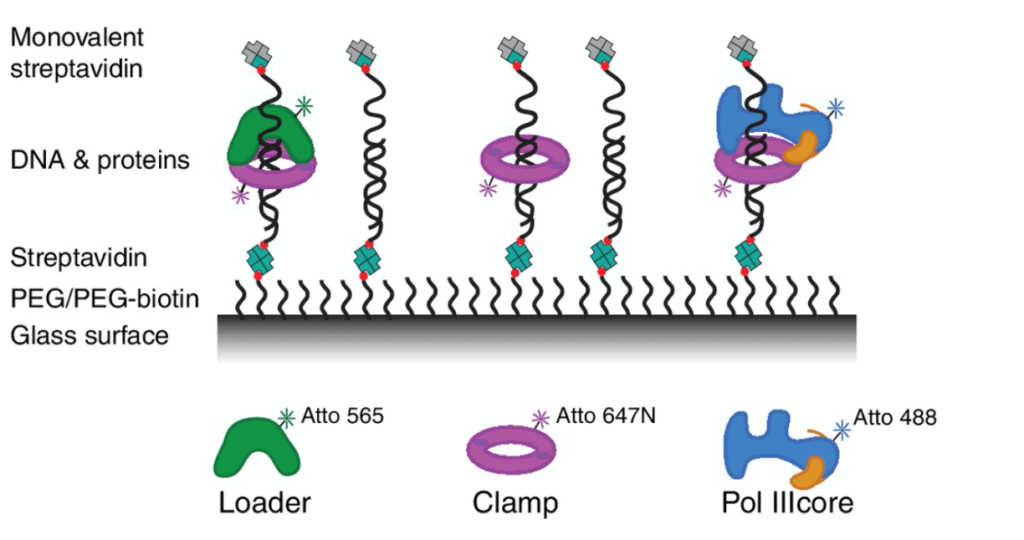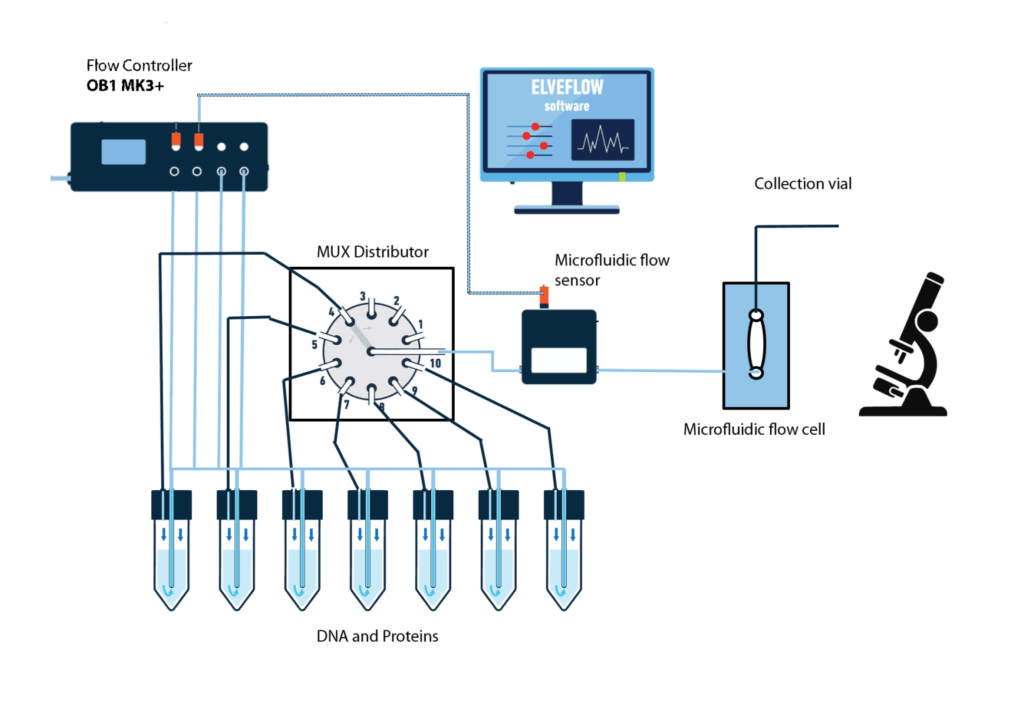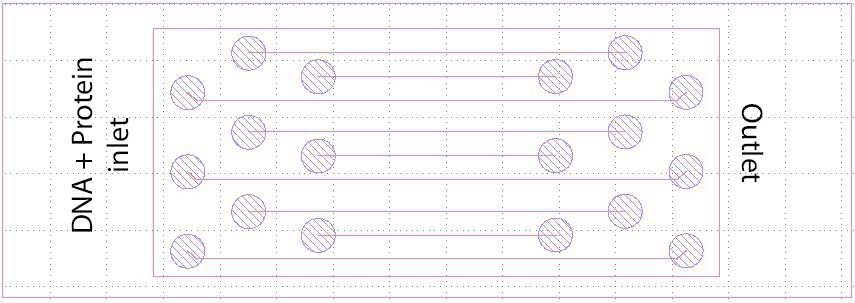Microfluidic colocalization setup for DNA analysis
Detect protein and/or DNA interaction with the help of microfluidics
Introduction to microfluidic colocalization
This user guide will show you how to run microfluidic colocalization studies of single molecule spectroscopy. We will start with the preparation of the flow cell and we will then show you how to apply pressure driven flow control to liquids for DNA detection studies.

Schematic depiction of DNA and protein colocalization. Single DNA molecules are attached to the glass surface using streptavidin as intermediate bonding agent. In this article we will describe how to perform microfluidic colocalization using an Elveflow setup.
Microfluidic colocalization setup
The imagining chamber consists of a microscope glass slide (1 mm thickness, 25×75 mm size) with etched channels (up to 9 channels on 1 glass slide) covered with a rectangular borosilicate coverslip (0,13 – 0,17 mm thickness, 60 x 22 mm size). The connectors for tubing were bound directly to the microscope glass slide because of its thickness.
In this experiment, we analyzed several proteins that we introduced into the flow cell using the ELVEFLOW© MUX distribution valve. Using this setup a minimal delay in the sequential injection can be achieved.

Materials for microfluidic colocalization
Hardware:
- OB1 flow controller (Elveflow) with a channel of 0-2000 mbar
- 1 MFS2 flow sensor (Elveflow) 0-7 μL/min
- Kit starter pack luer lock + 1/32 tubings + 1/32 sleeves + custom chip connectors
- 1-8 x 15 mL Falcon reservoirs
- Microfluidic chip
- FRET Microscope for observation
Chemicals:
- 20 mM Tris-HCl pH 7.5
- 50 mM potassium glutamate
- 8 mM MgCl2
- 4% glycerol
- 2 mM DTT
- 0.1% Tween20
- 1 mM Trolox
- Proteins or DNA molecules (Depending on experiment)
Microfluidic chip design
The bottom part of the chip is made of borosilicate glass, 0.13-0.17 mm. The top glass (cover glass) is a conventional microscope glass slide. The biggest channel length is 40 mm, the smallest 20 mm. Channel depth may differ, here 20-, 30- and 50-micron channels were etched.
The chip was produced by glass etching during the study. Channel width was 150 microns. On the top of the microscope glass slide we drilled inlet and outlet holes. Connectors: custom, made as part of the project. Tubing: external diameter 1 mm.

Quick start guide
Glass surface treatment to preassemble the flow cell
1. Wash the flow cell with bleach and inactivate the bleach with sodium thiosulfate.
2. Flow a solution of neutravidin, then flow with a casein and/or BSA solution to close gaps on the surface.
3. For “sticky” proteins, pre-treatment of the bottom glass slide by means of pre-silanization is usually required.
Bonding of DNA to the glass surface
Tips from the expert
Before starting the experiment, proteins and DNA should be labelled and purified using gel filtration. The extended protocol can be requested (classical protein purification).
4. Connect your OB1 pressure controller to an external pressure supply using pneumatic tubing, and to a computer using the USB cable. For detailed instructions on OB1 pressure-driven flow controller setup, please read the OB1 user guide.
5. Plug the microfluidic reservoir to the OB1 pressure controller outlet. The Elveflow reservoir connection instructions are covered by a specific guide (see Elveflow microfluidic reservoir assembly instructions).
6. For the feedback loop, connect a flow sensor to the OB1. Then, connect flow sensors between the microfluidic reservoirs and the chip for flow measurement.
7. Turn on the OB1 by pressing the power switch.
8. Launch the Elveflow software. The Smart Interface guide covers the Elveflow Smart Interface’s main features and options. Please refer to those guides for a detailed description.
9. Press Add instrument \ choose OB1 \ set as MK4, set pressure channels if required, give a name to the instrument, and press OK to save changes. Your OB1 should now be on the list of recognized devices.
10. OB1 calibration is required for the first use. Please refer to the OB1 user guide.
11. Add flow sensor: press Add sensor \ select flow sensor \ analog or digital \ max flow rate for the sensor, give the sensor a name, select to which device and channel the sensor is connected, and press OK to save the changes. For details refer to the Microfluidic flow sensor user guide.
12. Add MUX distributor: press Add instrument \ choose MUX distribution/injection \ give the instrument a name \ select the number of valves (10 or 12).
13. Connect the OB1 to the manifold and the manifold to all the reservoirs you need.
14. Use the supplied 1/32” OD tubing to connect the microfluidic reservoirs to the MUX distributor and one tubing at the outlet of the MUX distributor. Add a dead-end block to the inlets of the MUX-distributor that are not used.
Tips from the expert
Use consecutive MUX inlets for liquid reservoirs and the dead-end. The MUX will switch liquids following the shortest travel distance. Air will enter the system if the MUX passes over an open inlet.
15. Set pressures (and other parameters if needed) and start pumping liquids into the chip. Wait until all air bubbles escape from the chip and both liquids flow.
Tips from the expert
Chip priming: To begin with, run liquids into tubes until the liquid starts to drip for each inlet of the MUX distribution. Only then, connect them to the chip.
16. Flow continuously at 1µL/min using the flow sensor feedback loop (see Elveflow flow sensor User Guide) the following solutions in this order:
a. 10 µL of PBS
b. 5 µL of bio-BSA 0.1 mg/mL PBS
c. 5 µL of PBS
d. 5 µL of Pluoronics 0.5%
e. 5 µL of Neutravidin 0.2 mg/mL
f. 5 µL of Casein 0.02%
g. 5 µL of 20kb DNA bio (1 µL-0.5 ng) in PCB (19 µL)
Tips from the expert
PBS is phosphate-buffered saline and PCB is PBS with BSA (0.4 mg/mL) and casein (0.02%).
17. Incubate for at least 15 minutes at room temperature without flow.
18. Restart the continuous flow with the following solutions:
a. 5 µL PCB
b. 5 µL Neutravidin 0.2 mg/mL
c. 5 µL of Pluronics 0.5%
Microfluidic setup imaging
19. Different microscope setups can be used, for example, the Nikon (Kingston Upon Thames, United Kingdom) Eclipse Ti-E microscope with the ApoTirf 100X/1.49 Oil, 0.13–0.20 WD 0.12 objective.
20. We used lasers with 150 mW 488 nm, 150 mW 561 nm (both Coherent Sapphire Ely, United Kingdom), and 100 mW 638 nm (Coherent Cube) controlled by an acousto-optic tunable filter (Gooch and Housego, Ilminster, United Kingdom).
21. Each view field is about 50 x 50 microns, channels have a width of 150 microns to observe the molecules in the middle of the channel without any distortion or artifacts.
Congratulations!! You achieved the binding and monitoring of single molecules on chip! We hope this tutorial is a useful guide in your microfluidic experiments. If you need further details or additional information, do not hesitate to contact our experts!
This project has received funding from the European Union’s Horizon 2020 research and innovation programme under the Marie Sklodowska-Curie grant agreement No 722433 (DNARepairMan).